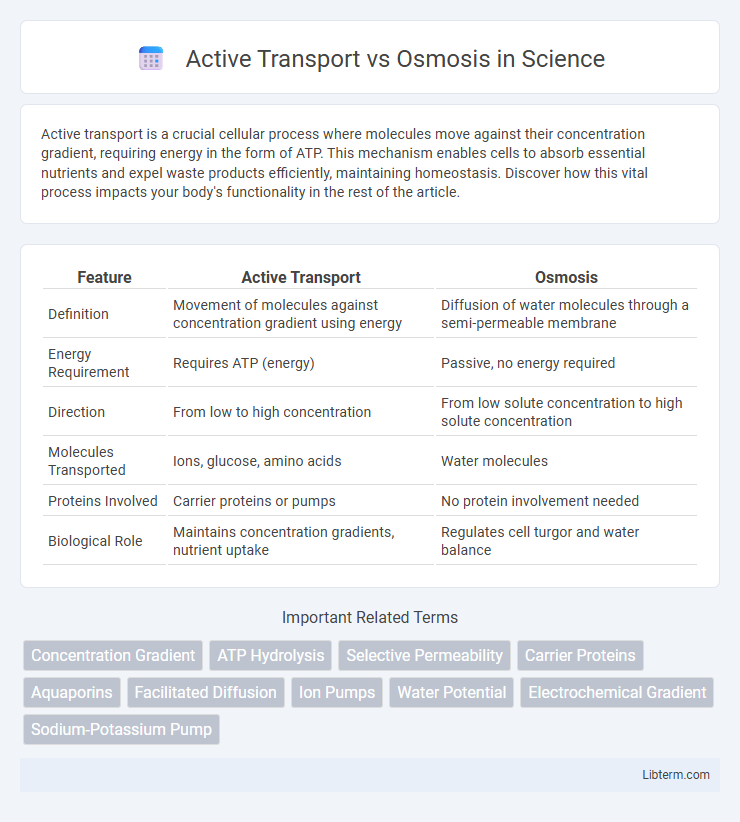Active transport is a crucial cellular process where molecules move against their concentration gradient, requiring energy in the form of ATP. This mechanism enables cells to absorb essential nutrients and expel waste products efficiently, maintaining homeostasis. Discover how this vital process impacts your body's functionality in the rest of the article.
Table of Comparison
| Feature | Active Transport | Osmosis |
|---|---|---|
| Definition | Movement of molecules against concentration gradient using energy | Diffusion of water molecules through a semi-permeable membrane |
| Energy Requirement | Requires ATP (energy) | Passive, no energy required |
| Direction | From low to high concentration | From low solute concentration to high solute concentration |
| Molecules Transported | Ions, glucose, amino acids | Water molecules |
| Proteins Involved | Carrier proteins or pumps | No protein involvement needed |
| Biological Role | Maintains concentration gradients, nutrient uptake | Regulates cell turgor and water balance |
Introduction to Cellular Transport Mechanisms
Active transport and osmosis are essential cellular transport mechanisms that regulate the movement of substances across cell membranes. Active transport requires energy in the form of ATP to move molecules against their concentration gradient via specific transport proteins, whereas osmosis is the passive diffusion of water molecules through a selectively permeable membrane from regions of low solute concentration to high solute concentration. These processes maintain cellular homeostasis by controlling nutrient uptake, waste removal, and water balance within cells.
Defining Active Transport
Active transport is the process by which cells move molecules or ions against their concentration gradient using energy, typically from ATP. Unlike osmosis, which is the passive diffusion of water through a semi-permeable membrane, active transport requires specific carrier proteins or pumps embedded in the cell membrane. This mechanism is essential for maintaining cellular homeostasis, nutrient uptake, and ion balance in various biological systems.
Understanding Osmosis
Osmosis is the passive movement of water molecules across a semipermeable membrane from an area of lower solute concentration to higher solute concentration, driven by osmotic pressure without requiring cellular energy. Unlike active transport, which requires ATP to move substances against their concentration gradient, osmosis relies solely on diffusion and the natural tendency to equalize solute concentrations on both sides of the membrane. Understanding osmosis is crucial for comprehending how cells maintain fluid balance and regulate internal environments in response to external changes.
Key Differences Between Active Transport and Osmosis
Active transport requires cellular energy (ATP) to move molecules against their concentration gradient, whereas osmosis is a passive process involving the net movement of water molecules across a semipermeable membrane from a region of low solute concentration to high solute concentration. Active transport utilizes specific carrier proteins and can transport ions, sugars, and amino acids, while osmosis specifically involves water movement without the need for transport proteins. The fundamental difference lies in energy usage: active transport is energy-dependent, while osmosis relies solely on passive diffusion driven by osmotic pressure.
Energy Requirements: Active Transport vs Osmosis
Active transport requires energy in the form of ATP to move molecules against their concentration gradient, enabling cells to uptake essential nutrients and expel waste efficiently. Osmosis, a passive process, involves the movement of water across a semipermeable membrane from a region of low solute concentration to a higher one without the need for energy input. The key distinction lies in active transport's energy dependence versus osmosis' reliance solely on concentration gradients to drive movement.
Role of Membrane Proteins in Transport Processes
Membrane proteins play a crucial role in both active transport and osmosis by facilitating selective movement of substances across the cell membrane. In active transport, specific carrier proteins use energy from ATP to move molecules against their concentration gradient, ensuring vital nutrients and ions enter the cell. During osmosis, channel proteins called aquaporins enable the passive diffusion of water molecules, maintaining cellular fluid balance without expending energy.
Examples of Active Transport in Living Cells
Active transport in living cells involves the movement of molecules against their concentration gradient using energy from ATP, exemplified by the sodium-potassium pump that maintains cellular ion balance by exporting sodium ions and importing potassium ions. Another key example is the proton pump in plant cells and mitochondria, which actively transports hydrogen ions to generate a proton gradient for ATP synthesis. This process contrasts with osmosis, where water moves passively across membranes without energy input, driven solely by concentration differences.
Biological Significance of Osmosis
Osmosis plays a critical role in maintaining cellular homeostasis by regulating water balance across semi-permeable membranes, ensuring cells neither swell excessively nor shrink. This process drives nutrient absorption and waste removal in plant roots and animal cells, directly impacting cell turgor and overall physiological function. Unlike active transport, osmosis operates without energy expenditure, relying solely on concentration gradients to facilitate passive water movement essential for life.
Physiological Implications of Both Mechanisms
Active transport requires cellular energy to move molecules against their concentration gradient, crucial for maintaining ion balance and nutrient uptake in cells. Osmosis involves passive water movement across semipermeable membranes, essential for regulating cell volume and maintaining homeostasis. Together, these mechanisms ensure proper cellular function by controlling solute concentrations and fluid balance in physiological systems.
Summary: Choosing Between Active Transport and Osmosis
Active transport requires energy to move molecules against their concentration gradient, making it essential for nutrient uptake and ion regulation in cells where passive movement is insufficient. Osmosis, a passive process, involves the movement of water molecules across a semipermeable membrane from low to high solute concentration to maintain cellular hydration and balance. Choosing between active transport and osmosis depends on whether solutes or water need to be moved and if energy expenditure is feasible or necessary for cellular function.
Active Transport Infographic

 libterm.com
libterm.com